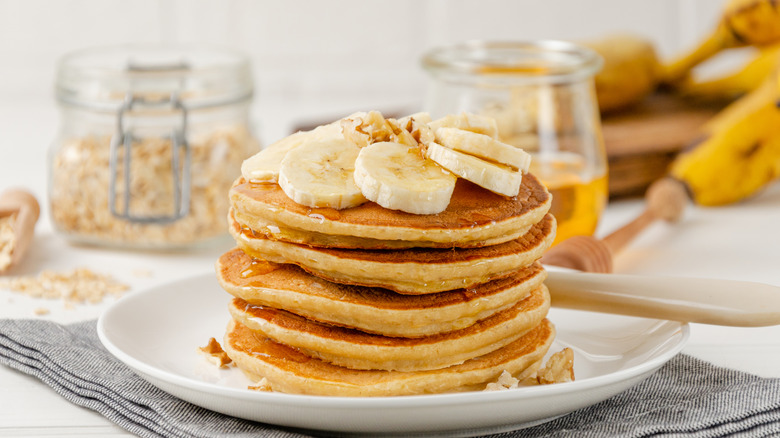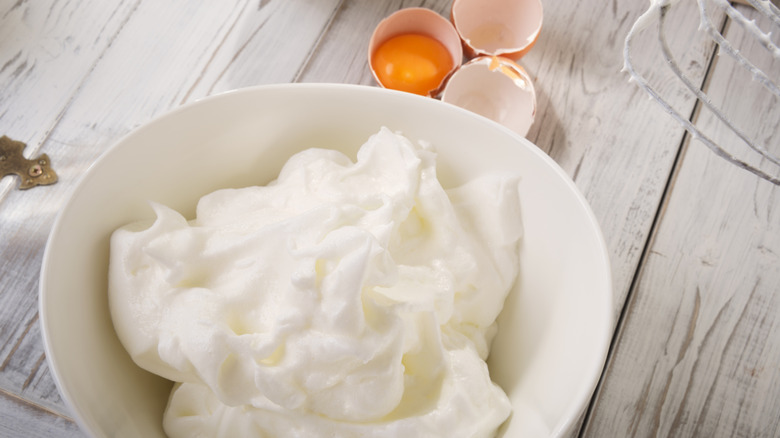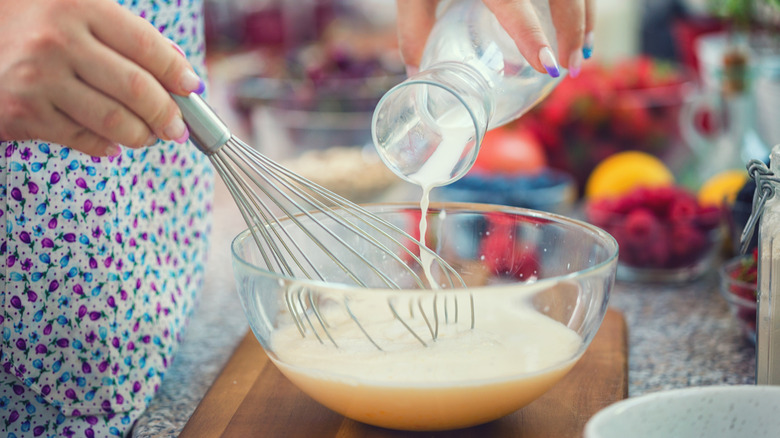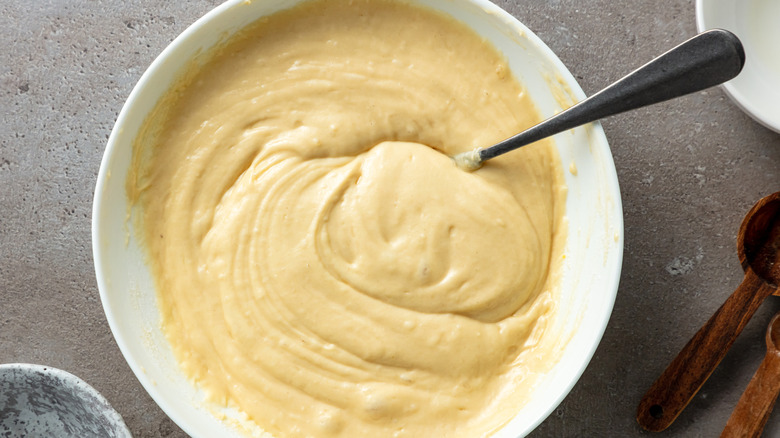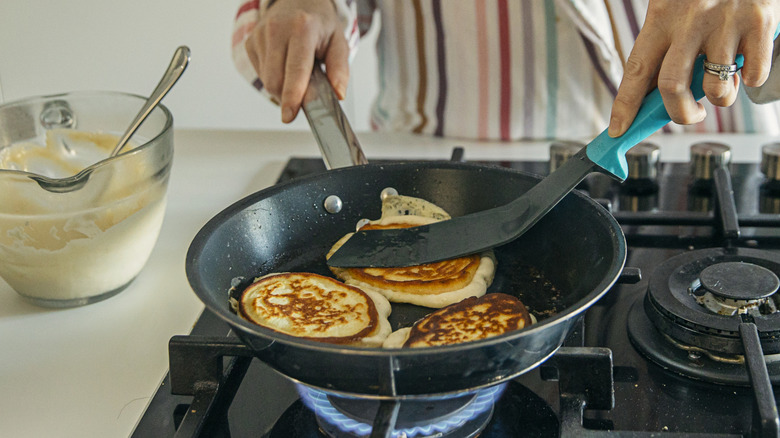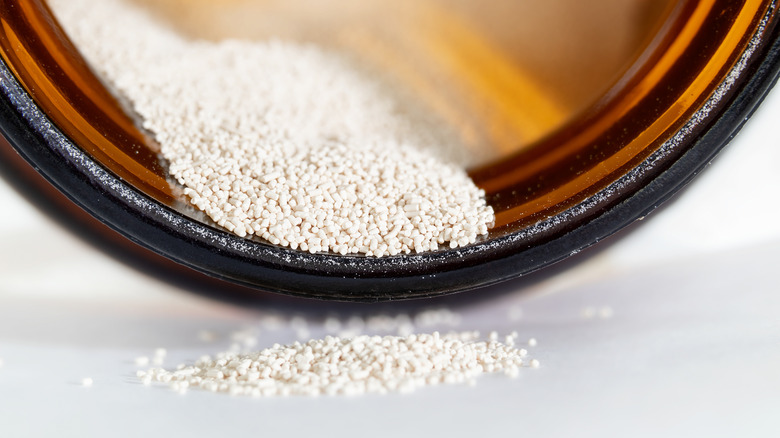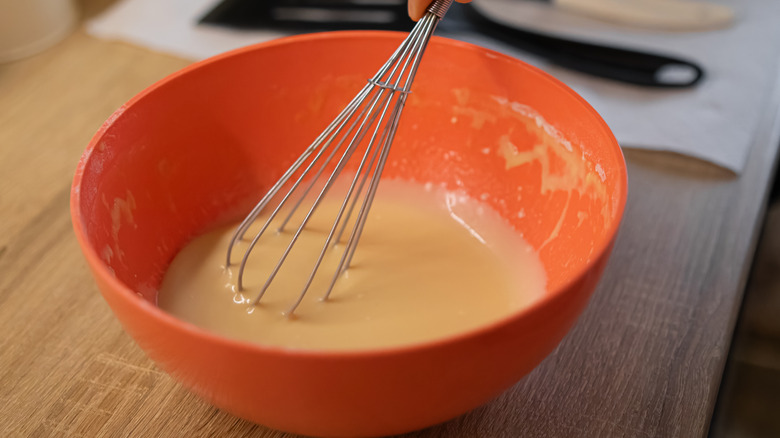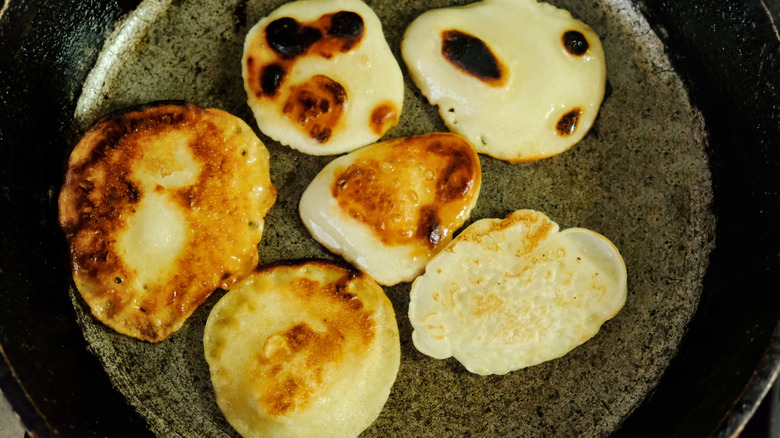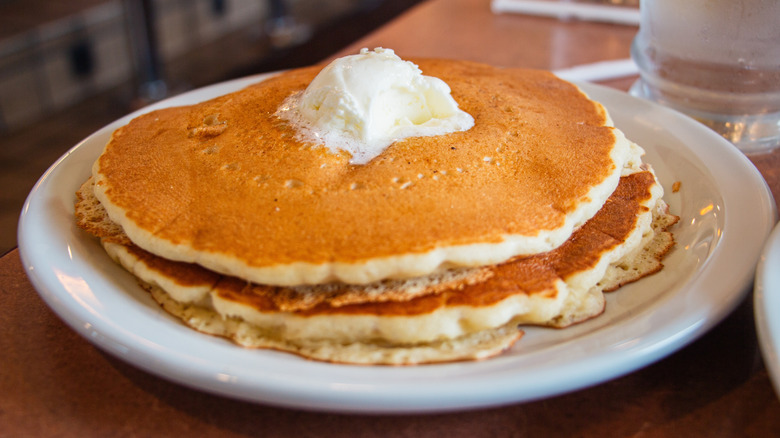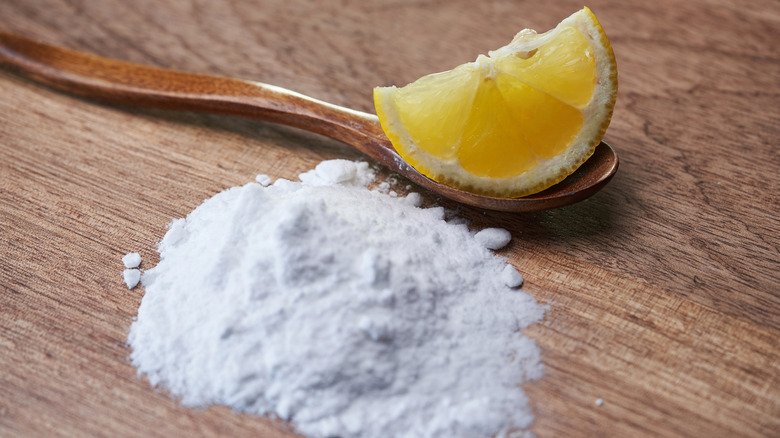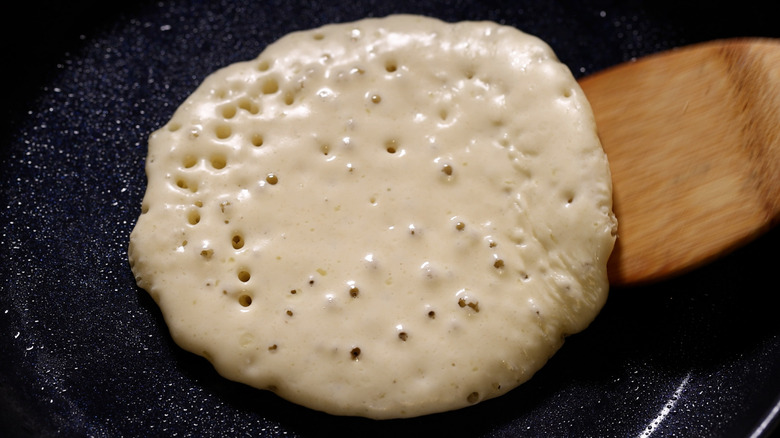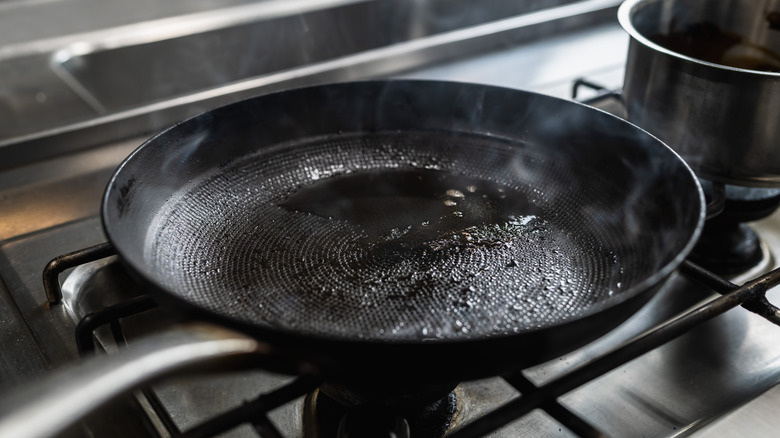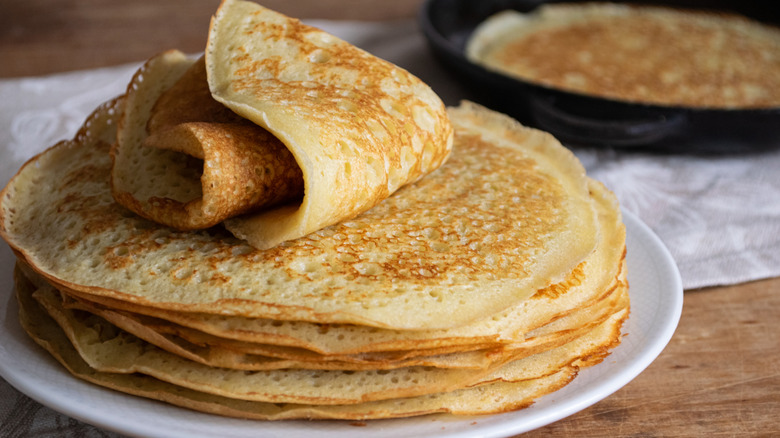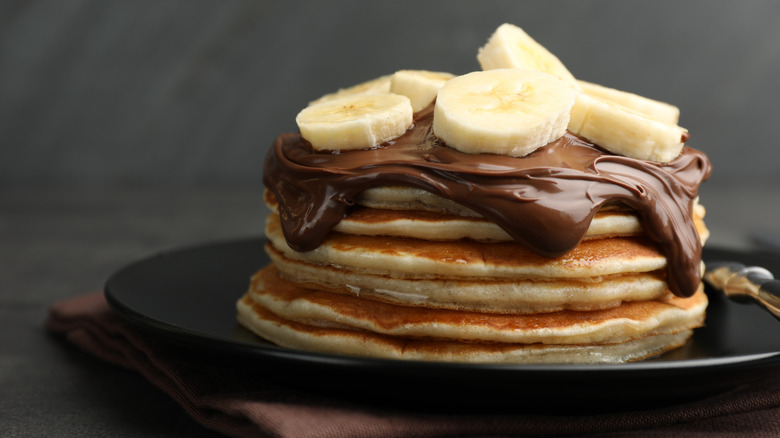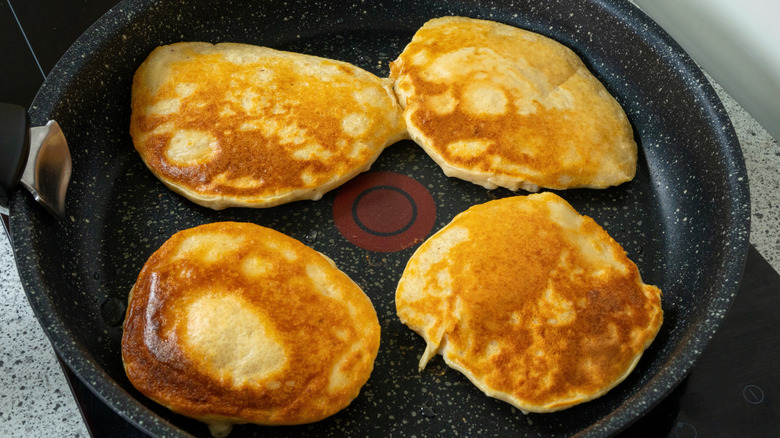14 Common Mistakes You Might Be Making With Your Pancakes
Move over, waffles — pancakes are the real star of Saturday mornings. With their fluffy interior, crisp edges, and buttery flavor, it's hard to think of a more scrumptious way to start the day. Even so, the act of making pancakes can be dreadfully nuanced and, as a result, can lead to unsatisfactory results on days when you crave them the most. Thankfully, we've got the info you need to flip yourself out of this rut, helping you to achieve the fluffiest and most tantalizing pancakes imaginable.
We've curated a list of the most common mistakes we see people making when it comes to pancakes and how to remediate them. From secret ingredients to fun techniques, we're here to unravel the details on exactly how you can achieve diner-worthy pancakes right from the comfort of your own kitchen. Join us as we explore 14 common mistakes you might be making when cooking pancakes so they can come out more delicious.
1. Neglecting to add whipped egg whites
Life's too short for flat pancakes — it's time to fluff things up a bit. Whipped egg whites are a fairly standard ingredient when it comes to waffles and Japanese soufflé pancakes, but did you know that traditional American-style pancakes can benefit from them, too? Adding whipped egg whites to pancakes helps create a fluffy texture, and though it'll be an extra step on your end, TikTokers like @problemsolved insist it's worth the effort.
So, how's it done? To add whipped egg whites to your pancake batter, simply separate the whites from the yolks before mixing the yolks into the batter with your other ingredients, and place your egg whites in a separate bowl. From there, you can either whip your egg whites by hand or skip the arm workout by using an electric mixer instead. Whip the egg whites until they are soft and foamy. Gently fold the egg whites back into your pancake mixture — just be careful not to overmix, as this may deflate your whipped eggs, rendering them useless. Cook your batter as you normally would and voila — you've got fluffy and delicious pancakes you'll crave over and over again.
2. Using traditional milk by default
There's nothing wrong with using traditional milk in pancakes — heck, you could even try using plant-based milk or water if your heart so desires. But if you really want to kick your pancakes up a notch, try adding buttermilk. The taste of buttermilk pancakes may invoke memories of "old-fashioned" pancake flavor, with its creamy and tangy essence giving your flapjacks a comforting and uniquely delicious taste, like a warm hug on a plate.
Though swapping traditional milk for buttermilk when making pancakes is a great idea, it's important not to do so haphazardly. Some ingredients in your pancake mix may negatively react with the acid in buttermilk, leaving you with flatter pancakes than what you desire. What are we talking about here? Leaveners. Believe it or not, combining buttermilk with baking powder, a common leavening ingredient in some pancake recipes, can spell trouble. Instead, you'll want to cut your baking powder component back by half, and for every cup of buttermilk, be sure to include a ½ teaspoon of baking soda (more on their differences later). The baking soda combines with the buttermilk to provide lift and airiness to your pancakes that'll prove downright delicious.
Don't have buttermilk? One of the best substitutes for buttermilk we've found is to mix together one part yogurt with two parts water. "Clabbered" milk is also an option, which simply combines a cup of milk with a tablespoon of lemon juice. You're welcome!
3. Not allowing your batter to rest
You may be wondering if resting your pancake batter is actually important. After all, when you're craving a fluffy stack first thing in the morning, the last thing you want to do is add extra time to the process, right?
While we won't say that you can't achieve delicious pancakes without resting the batter, we will at least say that doing so can make your pancakes 10 times better. Resting the batter has several functions that make it worth the extra step. The first is that by allowing your pancake batter to sit, you allow the gluten in the batter to relax. This results in a tender texture. In addition, resting the batter allows any leaveners in the mix to do their job. Remember the baking soda and baking powder we talked about earlier? Those need time to interact with the other ingredients in your pancake batter to work.
As you allow processes like these to take place, the results are fluffier, taller, and lighter pancakes. How long should you let the batter sit? Around 10-15 minutes is usually the sweet spot. Not great news if you're super hungry, but trust us, you'll be glad you did.
4. Pressing down on pancakes after flipping
There are some things we do as humans that make absolutely no sense. Aside from making the mistake of pressing down on burgers as they are cooking, we're often tempted to take on another culinary faux pas: intentionally flattening our pancakes as they sizzle.
Let's take a second to pause and reflect on why this might be a bad idea. Remember what we told you about the air bubbles in pancakes and how they lead to fluffy deliciousness? Well, pressing down on your pancake with a spatula can burst your bubbles by squashing the air right our of them. Instead of pressing down on your pancakes, simply flip them and forget about it. Allow the leaveners inside your pancake batter to do their job as that much-needed lifting action takes place. Your pancake will thank you for it — and so will your tummy.
5. Being hesitant to use yeast
Similar to whipping egg whites before adding them to pancakes, we realize that the addition of yeast to what is supposed to be a quick and enjoyable breakfast can make things more complicated. Even so, it's important to note that adding yeast to pancake batter has several benefits.
Not only does yeast produce more air bubbles to result in a fluffier cake, but it also imparts that uniquely yeasted flavor that only yeast can provide. Now, when it comes to how to add yeast to pancake batter, we've seen it done a variety of ways. Some heat milk over a saucepan while others add the sugar and active dry yeast directly to cold milk before combining the ingredients in one bowl. Either way, you'll want to let your yeasted pancake batter sit for at least 1 ½ hours (or even overnight if you're looking for the key to super fluffy pancakes). In general, the batter should be at least doubled in size before you head to the griddle.
6. Mixing pancake batter too vigorously
Overmixing pancake batter is easy to do, especially when you see lumps of flour swimming in the mix. And while it might be tempting to vigorously whisk the batter until it becomes smooth, doing so won't produce better results.
There are a couple of reasons why overmixing your pancake batter can lead to undesirable results. The first is that whisking or stirring your batter too vigorously deflates air bubbles, meaning you can kiss light and fluffy pancakes goodbye, even if you use the right ingredients (like yeast, baking powder, or other leaveners). Secondly, overmixing pancake batter will cause gluten to develop — every stir develops more gluten, making your pancake more of the texture of pizza dough rather than the tender and delicate savor of a good pancake.
If you seriously can't stand seeing lumps in your batter, there are a couple of paths you can take. The first is to whisk only your dry ingredients before adding your wet ingredients later on. This will get rid of any clumps of flour or baking powder and can help you achieve a smoother batter. The other tip is to allow your batter to rest. As it sits, the wet and dry ingredients will have more time to infuse, giving you a slightly less lumpy pancake mix.
7. Allowing the first pancake(s) to discourage you
First pancake got you down? It happens to the best of us. Still, if you'd rather not chuck it to the dog, there are a few ways you can keep your first pancake from looking like a burnt, undercooked, or unappetizingly speckled mess.
Our first tip is to always make sure you give your griddle or skillet enough time to heat up. Sometimes, your pancakes will turn out lighter than usual because you haven't given the pan enough time to heat up. In the same vein, be sure not to raise the temperature too high — doing so may render a pancake that's burnt on the outside and raw on the inside.
In addition to giving your skillet enough time to heat, you'll also want to ensure that your pan is evenly coated in oil (or butter). To do this, consider oiling your pan and wiping it out with a paper towel before cooking. This will ensure that your surface is evenly coated in oil without creating uneven hot spots that get you that ugly first pancake. Just be sure to roll up enough paper towels to get the job done — otherwise, you might burn your fingers while wiping.
8. Trying to achieve a uniformly brown pancake without a nonstick pan
You know those pancakes that have a uniformly golden brown surface that seem near impossible to recreate at home? We've got the answer for how to achieve them — but you'll need to pay attention. We've taken to Reddit for an answer to this one, and most agree that the key to uniformly browned pancakes (as opposed to speckled ones) is a nonstick pan. But it doesn't stop there.
While a nonstick pan can help you achieve golden diner-style pancakes, you'll also want to avoid cooking them in butter. Instead, add a bit of vegetable oil to your pan before wiping it back out with a paper towel, just as mentioned previously. It's also worth noting that some people don't use oil at all, though we'd only recommend this dry cooking method if your pan is truly nonstick.
Lastly, be sure to watch your heat; keep your nonstick skillet at medium-low for the best results when it comes to even browning. Experiment using different heat settings, oiling methods, and pan styles (cast iron pans can also work) to see which works best for you.
9. Confusing baking powder and baking soda
As we've already discussed, baking powder and baking soda are both often found in pancake recipes. Even so, the two aren't the same and neither should they be swapped for one another — unless you make the necessary adjustments, that is.
So, how do the two differ? Baking powder, like baking soda, is a white leavener often found in pancake recipes. It has a soft, powdery texture and reacts on contact with both liquid (the first rise) and heat (the second rise). Baking soda, on the other hand, is also white but is grittier in texture; it rises when it comes in contact with an acid, which means that buttermilk you've been wanting to add to your batter is going to make the perfect addition.
Since baking powder and baking soda behave differently within a mixture of ingredients, it's imperative that you don't mix up the two. With that said, it is still possible to swap one in for another. When it comes to substituting baking soda for baking powder in a recipe, you'll only need to make a few small tweaks. Try mixing one part baking soda with two parts acid (lemon juice or vinegar works well) to use in the place of baking powder, or use three times as much baking powder for an easy swap in a pancake recipe involving baking soda.
10. Not looking for bubbles before flipping your pancake
By now, you know that air bubbles play a significant role in making pancakes fluffy, but did you know it can also be a signal that your pancakes are ready to be flipped? While this may be a rudimentary concept to some, for those of you who have never heard of this trick, prepare to be wowed.
After pouring your pancake batter onto a hot skillet or griddle, you should allow your pancake to cook until little bubbles begin to pop up over the surface. This is carbon dioxide escaping your batter — as the bottom side cooks and solidifies, it forces CO2 up top. It isn't only bubbles you're looking for here though. Wait for the bubbles to pop before you initiate your flip. Once you flip the pancake, only cook it for a minute or so tops. Cooking it too long is a great way to end up with not-so-delicious pancakes, despite your best efforts.
11. Cooking your pancakes over too high of heat
This one's self-explanatory but could really do a number on your pancakes if you aren't careful. Cranking the heat up on your pan may be tempting, and indeed, it is a great way to get your pan nice and hot for cookin'. Still, it is imperative that you turn your heat back down, especially before you apply butter or oil to it, as forgetting to do so may not only leave you with burnt pancakes but a raw pancake in the center, too.
As a rule of thumb, set your griddle or skillet over medium heat and wait until the pan is hot enough. If you're unsure, add a drop of water to the pan; it should sizzle and disappear when hot enough for use. If you add fat in the form of butter or oil to the pan and notice immense smoking or immediate browning, it's possible that you've set your stove temperature too high. Adjust the heat, remove your pan from the burner, and allow it to cool before trying again.
12. Being afraid of a thinner batter
Using a thinner batter might not get your pancakes quite as tall as some of the others, but it'll often render softer cakes if you know how to cook them. We got this tip from Reddit, although truth be told, this is a method that we hold near and dear to our hearts in our own kitchens as well.
Though a thick batter tends to be the standard when making pancakes, adding a pinch more liquid than the recipe requires can lead to bigger, softer, and lighter pancakes, especially when cooked in soft and creamy butter. The texture reminds us of a crepe and pancake melded together in perfect harmony — thin but tender and incredibly rich in flavor.
When cooking with a thinner batter, you won't need to change much in terms of cooking method, but you will need to watch the time. Because of the batter's consistency, your pancakes may cook quicker than expected, meaning you might end up with tough and overcooked pancakes if you aren't watchful.
13. Being too devoted to pancake syrup
We all have our favorite pancake syrup brands, but how about stepping outside of the box for once? There are many fun pancake toppings out there including homemade whipped cream, ice cream, jam, bananas, honey, chocolate sauce, Nutella, peanut butter, berry compote, or even sprinkles. The best part? Experimenting with different ingredients and toppings can transform your pancakes into a new flavor adventure every time, taking your breakfast game to delicious new heights.
Aside from the previously mentioned fun toppings, remember that it is also worth spending the extra money to invest in real maple syrup. Pancake syrup and maple syrup are two different things, with the latter being free of refined sugar and other unnatural ingredients. And though not as pungent in flavor as pancake syrup, maple syrup contains a natural sweetness that can pack the authentic flavor of pure maple into every bite.
14. Overcrowding your pan
It's tempting to try to cook up as many pancakes at a time as possible, but doing so is going to cost you. Unless you have a long electric griddle or generously sized pan, attempting to cram several pancakes in one pan at once when there clearly isn't enough space might cause you to miss out on even browning and irresistibly crispy edges. Overcrowding your pan with any food lowers the temperature of the skillet and can thereby produce pancakes that aren't quite as evenly cooked and crispy as they could be. It may also make them quite difficult to flip with batter splattering and pancakes landing on top of one another. Talk about stressful!
To fix this problem, be patient and only cook the amount of pancakes you can reasonably fit in your pan at a time. This might mean 3-4 smaller pancakes or a single huge one. The key is to make sure there's enough surface space surrounding each cake so that the proper sizzling and browning action can take place alongside the proper amount of heat. There's a science to it, but like most things pancake-related, chef-worthy flapjacks take time.
